|
 |
| Adult, Los Angeles County |
 |
 |
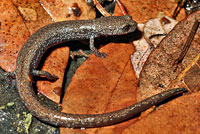 |
| |
Adult, Los Angeles County |
|
 |
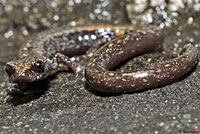 |
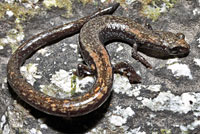 |
| |
Adult, Los Angeles County |
|
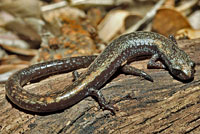 |
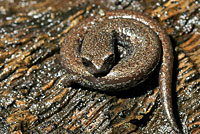 |
 |
| Adult, Los Angeles County |
Adult, coiling defensively |
Adult, Los Angeles County |
 |
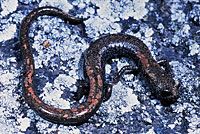 |
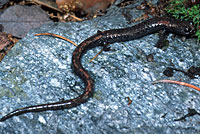 |
| Adult, Los Angeles County |
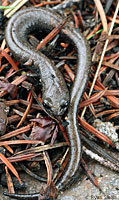 |
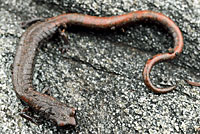 |
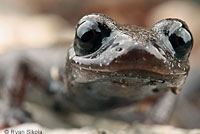 |
Adult, Los Angeles County
© Ryan Sikola |
Adult, Los Angeles County
© Ryan Sikola |
Adult, Los Angeles County
© Ryan Sikola |
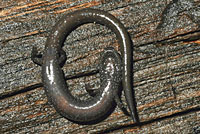 |
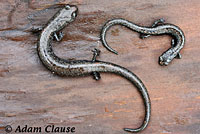 |
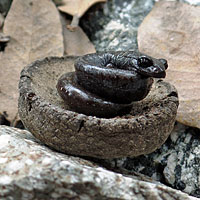 |
| Underside of adult, Los Angeles County |
Adult and Juvenile, Los Angeles County (captured and handled under state Scientific Collecting Permit and released at point of capture.) © Adam Clause |
Juvenile coiled up on acorn,
Los Angeles County |
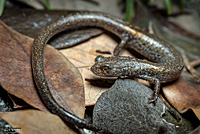 |
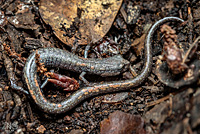 |
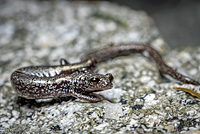 |
Adult, Los Angeles County
© Zeev Nitzan Ginsburg |
Adult, Los Angeles County
© Zeev Nitzan Ginsburg |
Adult, Los Angeles County
© Zeev Nitzan Ginsburg |
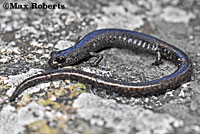 |
 |
|
Adult, Los Angeles County
© Max Roberts |
Slender Salamanders (genus Batrachoseps) have only 4 toes on their hind feet. All other California salamanders have 5 toes on their hind feet. |
|
| |
|
|
| Comparisons with Sympatric Slender Salamanders |
|
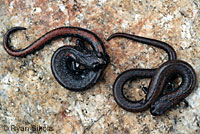 |
 |
Left: B. nigriventris -
Black-bellied Slender Salamander
Right: B. gabrieli
The two species coexist
at some locations in Los Angeles County. These two were found sheltering next to each other.
Note the larger more robust limbs and body of B. gabrieli.
© William Flaxington |
Left: B. gabrieli
Right: B. nigriventris -
Black-bellied Slender Salamander
L. A. County © Ryan Sikola
|
Left: B. major -
Garden Slender Salamander
Right: B. gabrieli (collected with permit)
Note the darker color of B. gabrieli and larger feet and toes. |
| |
|
|
| Habitat |
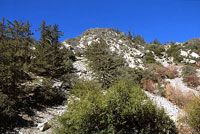 |
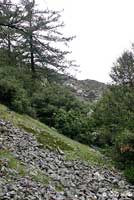 |
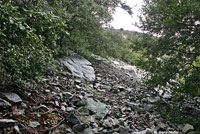 |
| Habitat, 3,800 ft., Los Angeles County |
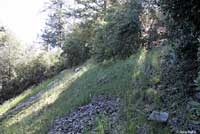 |
 |
 |
| Habitat, 3,800 ft., Los Angeles County |
Habitat, 3,800 ft., Los Angeles County |
Habitat, San Gabriel Mountains,
Los Angeles County |
 |
 |
|
| Habitat, 3,800 ft., San Gabriel Mountains, Los Angeles County |
Habitat, 3,800 ft. San Gabriel Mountains,
Los Angeles County
|
|
| |
|
|
| Short Video |
| |
 |
|
| |
An adult salamander crawling
in leaf litter under a shrub. |
|
|
|
|
| Description |
| |
| Size |
Adults are 1 1/2 to 2 inches long (3.8 - 5.1 cm) from snout to vent.
|
| Appearance |
A small slim salamander with 18 -19 costal grooves.
Short limbs, a long slender body with a narrow head and a long tail, and conspicuous costal and caudal grooves give this species the worm-like appearance typical of most Slender Salamanders.
Fairly robust for a Batrachoseps, with a fairly broad head, long limbs, large feet, and tapered tail.
There are four toes on the front and hind feet, which is typical of all Slender Salamanders.
(Other California salamanders have five toes on the hind feet.) |
| Color and Pattern |
Black above with a coppery to orange patchy dorsal stripe, becoming patches on the tail, and white speckling.
The underside is dark with scattered speckles.
|
| Comparison With Sympatric Slender Salamanders |
Co-exists with B. nigriventris in some localities.
B. nigriventris has a narrower head, shorter limbs, smaller feet, and a longer tail.
Found about 2 miles from B. major. (Stebbins 2003)
|
| Life History and Behavior |
A member of family Plethodontidae, the Plethodontid or Lungless Salamanders.
Plethodontid salamanders do not breathe through lungs. They conduct respiration through their skin and the tissues lining their mouth. This requires them to live in damp environments on land and to move about on the ground only during times of high humidity. (Plethodontid salamanders native to California do not inhabit streams or bodies of water but they are capable of surviving for a short time if they fall into water.)
Plethodontid salamanders are also distinguished by their nasolabial grooves, which are vertical slits between the nostrils and upper lip that are lined with glands associated with chemoreception.
All Plethodontid Salamanders native to California lay eggs in moist places on land.
The young develop in the egg and hatch directly into a tiny terrestrial salamander with the same body form as an adult.
(They do not hatch in the water and begin their lives as tiny swimming larvae breathing through gills like some other types of salamanders.)
|
| Activity |
Lives and in moist places on land.
Found under large rocks, logs, and bark.
Active on rainy or wet nights when temperatures are moderate, limited to the rainy season which is generally November through April.
Retreats into deep talus when temperatures rise and the soil dries.
Has been found while snow was present on the ground.
|
| Defense |
Slender salamanders use several defense tactics, including:
- Coiling and remaining still, relying on cryptic coloring to avoid detection.
- Uncoiling quickly and springing away repeatedly bouncing over the ground, then remaining still again to avoid detection.
- Detaching the tail, which wriggles on the ground to distract a predator from the salamander long enough for it to escape.
(After its tail is detached or severed, the salamander will grow a new tail.) |
| Diet and Feeding |
Eats small invertebrates, including ants.
A sit-and-wait predator, feeding with a projectile tongue. |
| Reproduction |
Reproduction is terrestrial.
Reproduction is thought to occur after the first heavy fall rains.
Nest sites have not been recorded, but other Batrachoseps species lay eggs in moist places on land.
|
| Eggs |
| It is presumed that eggs are laid deep underneath talus piles. |
| Young |
Young develop completely in the egg and hatch fully-formed.
|
| Habitat |
Closely associated with extensive rock talus on forested slopes, often near a stream.
|
| Geographical Range |
A California endemic, found in at least 13 locations, from San Gabriel Canyon in the eastern San Gabriel Mountains to Kimbark and Waterman Canyon in the extreme western San Bernardino Mountains.
|
| Elevational Range |
Occurs at elevations from 2,800 - 7,800 ft. (850 - 2,380 m.)
|
| Notes on Taxonomy |
Not discovered until the 1990's, which is unusual due to its close proximity to a heavily populated area. Described officially in 1996.
After the initial discovery of this species, more searches have been made in rocky talus, and more isolated salamander populations have been discovered. These salamanders are included with B. gabrieli, but some could warrant recognition as distinct species.
Here's a Diagram of the Batrachoseps Complex showing the relationships between species.
Alternate and Previous Names (Synonyms)
Batrachoseps gabrieli - San Gabriel Mountains Slender Salamander (Stebbins 2003)
Batrachoseps gabrieli - San Gabriel Slender Salamander (Wake 1996)
|
| Conservation Issues (Conservation Status) |
| Considered a sensitive species, most likely due to its limited habitat close to a heavily populated area. All known localities are on public lands in the Los Angeles and San Bernardino National Forests. |
|
| Taxonomy |
| Family |
Plethodontidae |
Lungless Salamanders |
Gray, 1850 |
| Genus |
Batrachoseps |
Slender Salamanders |
Bonaparte, 1841 |
Species
|
gabrieli |
San Gabriel Slender Salamander |
Wake, 1996 |
| Original Description |
Wake, David B. "A new species of Batrachoseps (Amphibia: Plethodontidae) from the San Gabriel Mountains,
southern California." Contributions in Science, Natural History Museum of Los Angeles County. 463. 1996.
|
|
Meaning of the Scientific Name |
Batrachoseps - Greek - batrachos = amphibian, frog + seps = lizard — describes lizard-like appearance
gabrieli - of the San Gabriel Mountains (type-locality.)
from Scientific and Common Names of the Reptiles and Amphibians of North America - Explained © Ellin Beltz
|
|
Similar Neighboring Salamanders |
Batrachoseps nigriventris - Black-bellied Slender Salamander
Batrachoseps major - Southern California (Garden) Slender Salamander
|
|
More Information and References |
California Department of Fish and Wildlife
AmphibiaWeb
Hansen, Robert W. and Shedd, Jackson D. California Amphibians and Reptiles. (Princeton Field Guides.) Princeton University Press, 2025.
Stebbins, Robert C., and McGinnis, Samuel M. Field Guide to Amphibians and Reptiles of California: Revised Edition (California Natural History Guides) University of California Press, 2012.
Stebbins, Robert C. California Amphibians and Reptiles. The University of California Press, 1972.
Flaxington, William C. Amphibians and Reptiles of California: Field Observations, Distribution, and Natural History. Fieldnotes Press, Anaheim, California, 2021.
Nicholson, K. E. (ed.). 2025. Scientific and Standard English Names of Amphibians and Reptiles of North America North of Mexico, with Comments Regarding Confidence in Our Understanding. Ninth Edition. Society for the Study of Amphibians and Reptiles. [SSAR] 87pp.
Samuel M. McGinnis and Robert C. Stebbins. Peterson Field Guide to Western Reptiles & Amphibians. 4th Edition. Houghton Mifflin Harcourt Publishing Company, 2018.
Stebbins, Robert C. A Field Guide to Western Reptiles and Amphibians. 3rd Edition. Houghton Mifflin Company, 2003.
Behler, John L., and F. Wayne King. The Audubon Society Field Guide to North American Reptiles and Amphibians. Alfred A. Knopf, 1992.
Robert Powell, Roger Conant, and Joseph T. Collins. Peterson Field Guide to Reptiles and Amphibians of Eastern and Central North America. Fourth Edition. Houghton Mifflin Harcourt, 2016.
Powell, Robert., Joseph T. Collins, and Errol D. Hooper Jr. A Key to Amphibians and Reptiles of the Continental United States and Canada. The University Press of Kansas, 1998.
American Museum of Natural History - Amphibian Species of the World 6.2
Bartlett, R. D. & Patricia P. Bartlett. Guide and Reference to the Amphibians of Western North America (North of Mexico) and Hawaii. University Press of Florida, 2009.
Bishop, Sherman C. Handbook of Salamanders. Cornell University Press, 1943.
Lannoo, Michael (Editor). Amphibian Declines: The Conservation Status of United States Species. University of California Press, June 2005.
Petranka, James W. Salamanders of the United States and Canada. Smithsonian Institution, 1998.
|
|
|
The following conservation status listings for this animal are taken from the April 2024 State of California Special Animals List and the April 2024 Federally Listed Endangered and Threatened Animals of California list (unless indicated otherwise below.) Both lists are produced by multiple agencies every year, and sometimes more than once per year, so the conservation status listing information found below might not be from the most recent lists. To make sure you are seeing the most recent listings, go to this California Department of Fish and Wildlife web page where you can search for and download both lists:
https://www.wildlife.ca.gov/Data/CNDDB/Plants-and-Animals.
A detailed explanation of the meaning of the status listing symbols can be found at the beginning of the two lists. For quick reference, I have included them on my Special Status Information page.
If no status is listed here, the animal is not included on either list. This most likely indicates that there are no serious conservation concerns for the animal. To find out more about an animal's status you can also go to the NatureServe and IUCN websites to check their rankings.
Check the current California Department of Fish and Wildlife sport fishing regulations to find out if this animal can be legally pursued and handled or collected with possession of a current fishing license. You can also look at the summary of the sport fishing regulations as they apply only to reptiles and amphibians that has been made for this website.
|
| Organization |
Status Listing |
Notes |
| NatureServe Global Ranking |
G2G3 |
Imperiled - Vulnerable |
| NatureServe State Ranking |
S2S3 |
Imperiled - Vulnerable |
| U.S. Endangered Species Act (ESA) |
None |
|
| California Endangered Species Act (CESA) |
None |
|
| California Department of Fish and Wildlife |
None |
|
| Bureau of Land Management |
None |
|
| USDA Forest Service |
S |
Sensitive |
| IUCN |
DD |
Data Deficient |
|
|
|






































